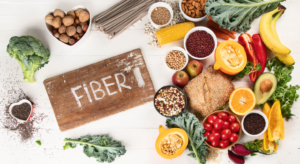
The Importance of Fiber Diversity in Supporting a Healthy Microbiome
Fiber is a compound that helps the digestive system remain regular. It supports a healthy gut microbiome, which is essential for numerous processes, such as the immune system and mental health. A correct diet reduces inflammation, along with the risk of heart disease and stroke.
According to the Center for Science in the Public Interest (CSPI), less than 3% of Americans get enough fiber—despite the rise of companies claiming and marketing processed foods as ‘high-fiber’ that often lack health benefits of whole-food sources. When it comes to gut health, diversity matters more than quantity—many people consume fiber, but often it’s the wrong type to support a diverse microbiome.
This article will go over the benefits of fiber diversity and how to increase fiber intake to benefit your gut.
What Is Fiber and How Does It Support the Gut?
Fiber is a non-digestible carbohydrate that is commonly found in plant-based foods. This compound interacts directly with our gut microbiota, which is the bacterial diversity in our small and large intestines.
Unlike other nutrients, our gut digests fiber slowly. The enzymes in our small intestines won’t be able to break it down, which means it’ll reach the colon mostly intact.
Fiber takes on different forms, depending on its fermentability level and water solubility. This includes the following:
- Soluble Fiber: Dissolves in water and creates a substance with a gel consistency. Gut bacteria break it down easily to create SCFAs such as butyrate, which is essential for proper gut support. You can find it in apples, oats, and legumes.
- Insoluble Fiber: It’s not fermentable, which means it does not contribute to SCFA production. However, it adds bulk to the stool, improving your bowel movements. It’s found in veggies, nuts, and whole grains, and can relieve constipation.
- Resistant Starch: This one’s similar to both soluble fibers, but it’s categorized as a “starch.” It’s non-digestible in the small intestine and ferments once it passes into the large intestine. There, it becomes food for the bacteria. You can find it in bananas, legumes, and cooked potatoes.
Some types of fiber serve as food for your good gut bacteria—this is what we call prebiotic fiber. This means that once it reaches the colon, it becomes food for the beneficial bacteria. After fermentation, the gut creates short-chain fatty acids (SCFAs). These compounds inhibit harmful bacteria, regulate gut pH, and reduce inflammation.
Why Is Fiber Diversity More Important Than Fiber Quantity?
Fiber diversity is more important than fiber quantity because every microbial strain needs different forms of “food.” For example, Eubacterium Eligens needs pectin-rich fiber to trigger anti-inflammatory effects. On the other hand, Bifidobacteria and Lactobacilli respond to beta-glucans when supporting gut health.
Limited-fiber diets are the most common option, especially in Western eating patterns. Refined grains are easier to obtain, but they lack fiber diversity. Microbiota-accessible foods are more difficult to come by, as they are more complex.
Most people get their fiber from limited sources such as corn or wheat. However, this can’t feed all the beneficial bacteria in the gut, which reduces resilience. It also creates an environment where the less beneficial strains are able to thrive. Fiber diversity builds resilience, which makes a poly fiber diet more beneficial.
Studies at the University of California using data from the American Gut Project show that poly fiber-rich diets improve microbial diversity by up to 84%. In the study, people consumed more than 30 different plants every week, which improved their gut flora.
How Do Different Fiber Types Feed Different Bacteria?

Different fibers, such as pectin, inulin, and cellulose, have a selective way of feeding beneficial bacteria in your gut. Consider it as a matching game, or like when you add a specific type of fuel to your car.
Bacteria only draw and feed from those fibers, promoting SCFAs and supporting your immune response.
There are countless microorganisms living in your gut. Here are a few examples:
- Inulin: Bifidobacteria break it down, creating beneficial SCFAs such as lactate or acetate.
- Pectin: Feeds butyrate, such as Faecalibacterium Prausnitzii, and promotes gut health along with reduction of inflammation.
- Cellulose: Broken down by anaerobic bacteria such as Ruminococcus and Fibrobacter Succinogenes, which support gut motility.
These fermentable fibers are all part of a category referred to as microbiota-accessible carbohydrates (MACs). This helps create SCFAs that modulate the immune function, modulate the pH, and improve colonocyte energy.
Bacteria such as Akkermansia don’t use dietary fibers directly. Instead, the bacteria specialize in substrates such as mucin. Its population increases when you consume enough fiber to improve the mucus barrier in the gut.
What Are the Health Benefits of a Diverse Microbiome?
Fiber diversity offers health benefits such as inflammation control, regulated SCFA production, and long-term immune health. Here’s an expanded list of the benefits it brings:
- It supports a wider range of beneficial bacteria, adding to overall gut health
- The SCFAs lower inflammation, which prevents inflammatory conditions
- Regulates the immune system and prevents it from overreacting
- Offers the gut better resilience to withstand harmful pathogens
- Improves gut lining, preventing it from becoming permeable and developing leaky gut syndrome
- Aids metabolic regulation by supporting nutrient digestion
- Balances the blood sugar levels, which reduces the risk of insulin resistance
The gut is connected to the brain via the gut-brain axis. If the gut is healthy with a diverse microbiome, it sends those signals to the brain via the vagus nerve.
Studies at the University of Perugia and the University of Naples Federico II, led by Gina Cavaliere, show that butyrate reduces neuroinflammation. This improves mental clarity and cognitive functions.
A balanced microbiome offers anti-inflammatory effects and improves gut integrity. The more beneficial bacteria your gut has, the more adaptive it will be to potential disruptions. This presents issues such as dysbiosis.
What Foods Contain the Most Diverse Fiber Types?
Foods that contain the most diverse fiber types include oats, leafy greens, and green bananas. Remember that each food category contains multiple types of fiber, but they are categorized by their predominant type.
Soluble fibers are highly fermentable and create a gel-like substance that’s beneficial for the gut. These foods fuel microbes and promote the production of SCFAs.
Studies by Kristen G Hairston at the Wake Forest University School of Medicine also show that increasing your soluble fiber intake by 10 grams reduces visceral fat by 3.7% within five years.
The most popular soluble fibers include:
- Oats
- Citrus
- Apples
- Barley
- Carrots
- Avocados
- Psyllium
Insoluble fiber adds bulk to your stool and supports regular bowel movement. This helps you in circumstances such as constipation and diarrhea. Common types include:
- Leafy greens
- Seeds and nuts
- Bran
- Cruciferous vegetables
- Whole grains
There’s also a fermentable fiber category that resists digestion called “starches.” Starch-rich foods include:
- Green bananas
- Cooked/cooled potatoes
- Legumes such as chickpeas and lentils
- Cooked/cooled rice
- Vegetable roots such as beetroot
Studies show that vegetable roots have a high-water content between 75% to 95.4%. This improves digestion while preventing issues such as diarrhea.
A microbiome-friendly diet will contain all of these fiber types in balanced quantities. Different fibers nourish different microbes, and the meals change bacterial balance.
Rotate the foods regularly to make the most of your meals. This exposes the gut to a variety of nutrients, creating an adaptive microbial environment.
How Can You Easily Increase Fiber Diversity in Your Diet?
You can easily increase the fiber diversity in your gut by choosing plant diversity in your dietary plan. Below are some actionable strategies:
- Eat 30 different plant foods per week
- Swap the plant choices every week
- Eat based on the changing seasons
- Add color to every food plate
- Prioritize variety over volumes
- Try incorporating all types of fibers in your daily meals
- Snack on nuts and seeds
- Create a structured food diary with your meal plans
Your food choices shape microbiota, so it’s best you choose organic food when possible. Studies by the Interdisciplinary Center for Studies and Research in Agribusiness in Brazil show that 69% to 84% of conventional food in stores does not reach nutritional consensus.
Consider adding those ingredients to a smoothie or cooking some missed dishes to meet your weekly goals. A single smoothie contains 5 to 7 plants on average, which brings you closer to your weekly fiber diversity goal.
A rich diet diversifies flora, but make sure to check the label and count your fiber. According to the CDC and data from Dietary Guidelines for Americans, the average adult should consume 22 to 34 grams of dietary fiber per day.
Why Do Processed Diets Undermine Microbiome Health?

Processed foods reduce bacteria and undermine microbiome health because they are poor in nutrients. The processing stage alters the macronutrient provisions, which means that ultra-processed foods lack the fermentable substrate.
Many processed foods and vegetables obtained through rapid growth have a diluted nutrient diversity. Industrial farms prioritize speed over quality, which depletes the fermentable plant fiber content.
This starves the beneficial bacteria and reduces their diversity. Since they can’t eat, the production of SCFAs becomes lower. Fewer MACs in the gut leave the harmful bacteria in charge, which compromises the gut barrier. Inflammatory responses become more frequent with fewer SCFAs in the body.
When the fiber diversity is low and the additives are high, these diets deplete microbiome balance. It also increases gut permeability, which allows toxins to pass through the gut lining and enter the bloodstream. This leads to immune overactivation and possibly autoimmune diseases.
Can Increasing Fiber Diversity Help Reverse Dysbiosis?
Increasing the diversity of fibers restores equilibrium and reverses dysbiosis on their own, but not always. It depends on the quality of ingested fiber, along with the severity of your microbiome imbalance.
Some individuals have a sensitive gut. This means they respond differently to fibers.
Below are certain situations when it’s recommended to reintroduce the fiber gradually:
- SIBO: SIBO causes bacterial overgrowth, and high-fiber foods exacerbate the symptoms. Consider following a FODMAP diet to correct fiber intolerance.
- IBS: Irritable bowel syndrome makes people more reactive to fiber, especially the soluble kind. Introduce fibers one at a time to determine the tolerance level.
- Post-Antibiotic Dysbiosis: The gut lining is inflamed after antibiotics, and too much fiber irritates the mucosa. Consider adding cooked vegetables before moving on to the raw kind, since they’re easier on the gut.
Fiber is just one part of your broader healing strategy. Make sure to combine it with other supportive strategies that heal the gut. Limit alcohol and irritants and avoid processed foods. Work with a naturopath to develop a holistic diet that works best for you.
- Post Title : The Importance of Fiber Diversity in Supporting a Healthy Microbiome
- Author: Dr. Susan Cucchiara, N.D.
- Clinically reviewed by - Dr. Susan Cucchiara, N.D.
- Date Published :


